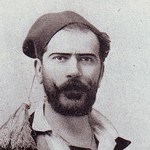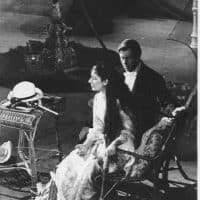 Spanish tenor Fernando Valero was born in Écija in the province of Sevilla, on 6 December 1856. He first studied law, but then took to singing under Martin Salazar and the legendary tenor Enrico Tamberlick. He made his debut as Lorenzo at the Teatro Real in Madrid in 1878, in Auber’s opera “Fra Diavolo.” From 1880 he sang in Italy, making his first appearance at the Teatro Brunetti in Bolgona in Ponchielli’s opera “I Promessi Sposi,” followed by performances in several provincial theatres throughout Italy, in operas such as “La Favorita,” “Faust,” “Puritani” and “La Sonnambula.”
Spanish tenor Fernando Valero was born in Écija in the province of Sevilla, on 6 December 1856. He first studied law, but then took to singing under Martin Salazar and the legendary tenor Enrico Tamberlick. He made his debut as Lorenzo at the Teatro Real in Madrid in 1878, in Auber’s opera “Fra Diavolo.” From 1880 he sang in Italy, making his first appearance at the Teatro Brunetti in Bolgona in Ponchielli’s opera “I Promessi Sposi,” followed by performances in several provincial theatres throughout Italy, in operas such as “La Favorita,” “Faust,” “Puritani” and “La Sonnambula.”
In 1882 he sang in Buenos Aires, in 1884 in Wien and in 1885 in St. Petersburg. To Milan’s La Scala he arrived in 1883, making his debut as Gounod’s “Faust,” which led to a successful collaboration for nearly a decade, the milanese audiences eventually dubbing him “Il Piccolo Gayarre,” after the great Spanish tenor.1 At La Scala he sang in the first Italian version of Bizet’s “Les Pechêurs de Perles” (1886), and in 1891 as Turiddu in the first performance of Mascagni’s “Cavalleria Rusticana,” a role he also created for Firenze. He made a further name for himself in 1895, when he sang the role of “Werther” at La Scala.
Valero enjoyed engagements at several important international opera stages: Berlin, Lisboa, Chicago; at London’s Covent Garden (1899, 1901), where he made his debut in a role that soon were to become his, Don José in Carmen, but his single most important performance here was perhaps his Duke in Rigoletto in 1901, opposite Nellie Melba’s Gilda and Jean Lasalle’s Rigoletto. The Met saw him during the 1901-02 season, during which he performed in Cavalleria Rusticana (Turiddu was his debut role with the opera in New York), Rigoletto, Martha and Carmen. He was yet again considered a stunning Don José, now his official gloss role.
In 1897, and at the end of his career, he suffered a pulmonary desease and had to interrupt his singing for a longer period. He eventually retired in 1902 and settled in St. Petersburg, where he opened a vocal academy. He passed away in this city in February 1914.
The voice of Valero was reminiscent to that of his predecessor and fellow countryman, Julian Gayarre, and for which he was dubbed “the little Gayarre” at La Scala. Like Gayarre, he had a sweet upper register, while the lower registers were robust and varonil. He betrayed exceptional breath support and was capable of sustaining a note for a considerable amount of time. He was also a notable actor. Valero was most succesful in lirico-spinto roles such as Don José in Carmen, Turiddu in Cavalleria Rusticana and Des Grieux in Manon Lescaut, the latter in which he was Puccini’s preferred tenor. He was, however, equally triumpant in the French lyric repertoire, in particular as Werther in Massenet’s opera by the same name.
As a token of his art, he recorded six2 sides for Red G&T in Milano and London in 1903, the year after his retirement: Dormi pure (Scuderi), the Siciliana from Cavalleria Rusticana, Viva il vino, El Amor es la Vida, La donna è mobile and Mattinata.









